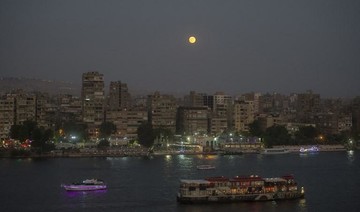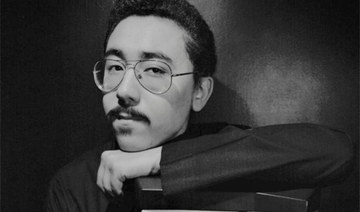CAIRO: Standing before a rapt crowd, Ahmed Adel oozes charm with his passionate performance of an Egyptian classic, evoking a romantic nostalgia for Arabic songs of the past.
After a melodious introduction on the Oud, the famed oriental lute, Adel croons his way through a "Mawal", a traditional melody boasting long vowels.
"Ya leil" ("O night"), he sings, with the dreamy languor of the original performer, Egyptian legend Mohamed Abdel Wahab.
With cheers of "Allah!", the mesmerised audience shows its appreciation.
"Modern songs are a hit for a day or two, a month, or maybe a year, but then we do not hear about them any more.
"But Abdel Wahab and (Egyptian diva) Umm Kulthum have lasted until today," said Adel, before his performance in the tiny Mamluk-era hall at the Arab Music Institute.
Egypt, a cultural powerhouse in the Arab world, has long enjoyed a booming music industry.
In the past, the rise of revered singers, such as Umm Kulthum, Abdel Wahab and another Egyptian Abdel Halim Hafiz among others, saw Cairo billed as the Hollywood of Arab song, attracting talent from across the region.
But in the 1990s, Gulf countries vying for cultural dominance emerged as rivals to Egypt's music industry, and Rotana, the Arab world's largest record label, was formed in 1987.
The company is currently owned by businessman and Saudi prince, Al Walid bin Talal.
The 2011 uprising in Egypt that plunged the country into political and economic chaos also saw a downturn in the domestic music industry.
Yet the Egyptian metropolis remains alive with the sound of music.
Every day, in local cafes and homes the melancholic songs of Syrian-born star Asmahan and the tender rhythmic melodies of Egyptian singer Najat al-Saghira mix with animated conversations, modern pop music and Islamic chants.
Torn between stage fright and joy, Adel performs regularly at the Arab Music Institute paying tribute to his music idols.
During events such as the "Khulthumiat" (the music of Umm Kulthum) or "Wahabiyat" (the music of Abdel Wahab), organised by the 100-year old institute, Adel is often the lead singer with an entire troupe from the Cairo Opera House accompanying his powerful vocals.
"These events are very successful," said Jihan Morsi, the seminal director of the opera's Oriental Music department.
And to soar above Cairo's 24-hour cacophony, she doesn't just look to golden oldies.
"I bring (pop stars like) Angham, Saber El-Robai, Wael Jassar. They are beautiful voices that have an audience among the youth," said Morsi.
Music production companies are also seeking to preserve the country's music heritage through younger generations.
Sawt al-Qahira, or Sono Cairo, a historic record company, is betting on the internet despite financial setbacks and ongoing legal battles over the copyright to Umm Kulthum songs.
Known as the "Star of the Orient," Umm Kulthum's voice is still considered the Arab world's finest, more than four decades after her death.
And with its wide variety of classics, the record label has struck deals with YouTube and other mobile application companies to keep this heritage alive.
Younger generations have also shown a renewed interest in the classics thanks to popular televised talent shows.
"Arab Idol, The Voice and others show people singing old songs," said Doaa Mamdouh, the company's internet services head, adding this has prompted many fans to dig out the original versions.
Classic black and white music video clips struggle, however, to compete against today's torrent of slick, ultra-modern videos.
Rising artists from such places as Lebanon, Morocco and the United Arab Emirates harness millions of views on YouTube, usually singing in their own dialects.
Egypt's music scene remains vibrant, including electro Shaabi music, an exuberant popular blend seen by purists as too raucous.
And there is a new genre known as alternative, or "underground", which has emerged in recent years.
The band Massar Egbari, which roughly translates as Compulsory Detour, rose to fame with a relaxed style of rock and a distinctive performance of classics, such as by Sayed Darwish often called "the father of modern Arab music".
Although the rock stars say they are influenced by classics, they don't want to live in the past.
"Nowadays you can record something at home at a low cost," said bassist Ahmed Hafiz. "After every era, something new appears, these are phases."
The band, whose style its guitarist and vocalist Hani el-Dakkak describes as a blend of Sayed Darwish and rock band Pink Floyd, is also trying to distinguish itself through its message.
"We try in our lyrics to talk about social problems or things that nobody else will speak about," said el-Dakkak.
Egypt tunes into nostalgia for golden age of Arab song
Egypt tunes into nostalgia for golden age of Arab song
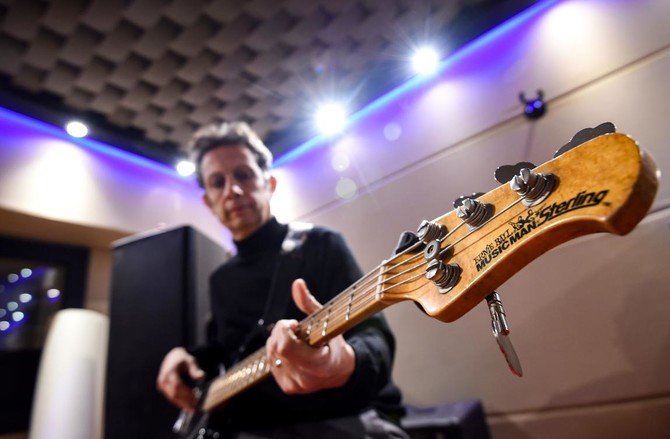
- Gulf countries vying for cultural dominance emerged as rivals to Egypt's music industry
- The 2011 uprising in Egypt also saw a downturn in the domestic music industry
REVIEW: ‘Returnal’ — a thoughtful and challenging sci-fi adventure
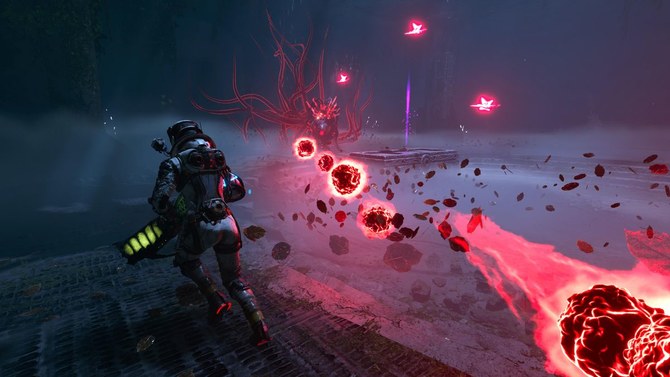
LONDON: Right from the start, before you even take control of Selene Vassos, a reconnaissance scout who has crash landed on a prohibited and mysterious planet, you are warned that “Returnal” (available originally for PS5 but now PC too) is “intended to be a challenging experience.” Such difficulty may deter the casual gamer used to a steady progression of character and exploration through a games environment. However, “Returnal” is a thoughtful and rewarding adventure that lays claim to much originality of thought in its set up. The key theme is that when you die, you return! But not to the same environment that you were in before. Instead, each new cycle postures new challenges and progress can only be made by unlocking upgrades that allow you to make more meta progress in Selene’s journey.
Selene herself is a super professional, unfazed character who doesn’t appear too bothered when she comes across a body of her former self that died in this strange world where the laws of physics and time appear not to apply. Staying alive is obviously crucial, particularly as it allows her to retain better weapons for longer. In addition, avoiding damage allows for boosts of agility, vision and more, making for a more lethal Selene. The environment is varied and surprising with each incarnation and the weapons on offer come complete with a range of exciting alternative fire mechanisms such as homing missiles or laser-like items. A hostile environment where even plants are a threat to life is mitigated by your technology, the core of which you can improve despite the reset of deaths, through fancy smart “xeno-tech” that becomes integrated with alien kit left around.
There is a paradox in “Returnal” described by Selene herself that she is trapped in an environment that is “always the same, always changing,” which literally makes no sense. Players have to be patient in the early chapters getting used to the sapping dynamic of death and return. Once that makes more sense, the loneliness of both her alien environment and the impossibility of even dying to escape it make for a pretty special atmosphere that a smart shooting engine then complements.
Artist Abdullah Al-Saadi represents the UAE at Venice Biennale
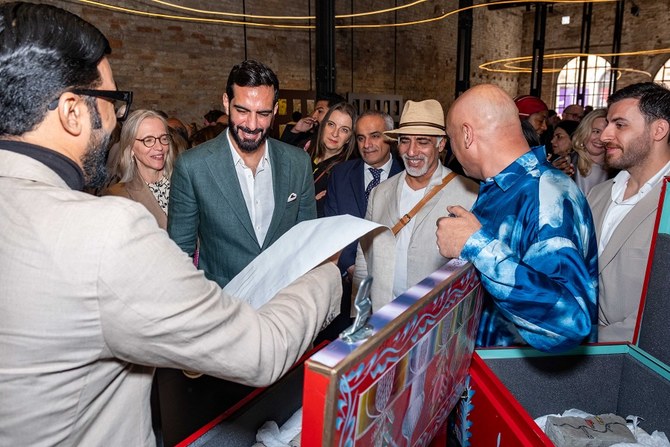
VENICE: Emirati conceptual artist Abdullah Al-Saadi is representing the UAE at the 60th Venice Biennale, curated this year by Adriano Pedrosa under the theme of “Foreigners Everywhere. Stranieri Ovunque.” The pavilion’s exhibition, which opened on April 20 and runs until Nov. 24, was curated by Tarek Abou El-Fetouh.
Al-Saadi has played a pivotal role in the development of the UAE’s evolving art scene — his multidisciplinary practice includes the mediums of painting, drawing, sculpture, performance and photography, as well as collecting and cataloguing found objects and the creation of new alphabets.
“Since I was a student, four decades ago, art has been an integral part of my daily life,” Al-Saadi said in a statement. “My art is the result of interactions with places, people, ideas, and aesthetics that I encounter every day where I live and in my journeys. I find myself driven to document these experiences visually or in written diaries and contemplations, seeking to transfigure the ordinary with the passage of time.”
“I am representing myself in Venice as an artist foremost and then as a local Emirati artist,” Al-Saadi told Arab News. “This pavilion will showcase my artistic journey over a long period of time since after university through eight works, two of which are new commissions,” he said of the ongoing show titled “Abdullah Al-Saadi: Sites of Memory, Sites of Amnesia.”
One of the artistic journeys he made that will serve as a new artwork took place amid the Arabian landscape.
“I spent seven days in the valley studying the tea, the coffee, and bread,” Al-Saadi explained to Arab News. “Then after one week I rode my bicycle, and I went to the mountains. During that time, I was reading a book on the Silk Road and trying to imagine how it was to travel on the Silk Road and I compared my way of traveling with how it was to travel on the Silk Road long ago.”
“Abdullah’s work is comprised of multiple aspects, from his diaries to sketches, to landscapes, scrolls and other objects that he creates,” Laila Binbrek, Director of the National Pavillion UAE, explained to Arab News. “They all stem from his diary — a diary he has been keeping for the last 40 years. Every day he writes in his diary.”
Christie’s Art of the Islamic and Indian Worlds auction highlights rare finds in London
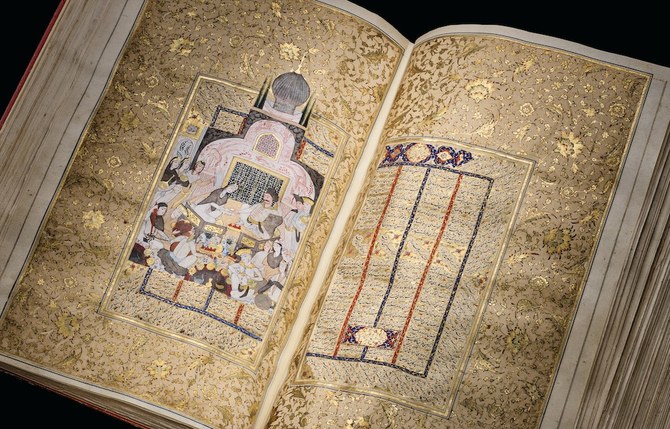
LONDON: Christie’s Art of the Islamic and Indian Worlds spring sale will see 261 lots —including paintings, ceramics, metal work, works on paper, textiles, rugs and carpets — go under the hammer at a live auction at their London headquarters on April 25.
Arab News was given an exclusive viewing of some of the works prior to their public pre-sale showing from April 21-24.
Sara Plumbly, Christie’s Head of Department for Islamic and Indian Art, gave her expert insights into some selected pieces.
These included lot 45, an exquisite miniature octagonal Qur’an, dated AH 985/1577-8 AD, which was made in Madinah, the Qur’an has an estimate of $13,000-19,000.
“We very rarely see manuscripts that were copied in the holy cities. So this being copied in Madinah makes it very rare,” she explained.
“It has a Naskh script. This a very steady, cursive script which is relatively easy to read — unlike some of the others. For example, Nastaliq script, which is copied on the diagonal, is much trickier to read. For Qur’ans you would almost always see a Naskh script for ease of reading. Nastaliq is usually reserved for poetic manuscripts,” she said.
This miniature Qur’an would be small enough to carry with the owner on a daily basis, usually around the neck. Alternatively, they would be hung in their silver boxes on an ‘alam (standard or flag) and carried into battle.
Plumbly, who completed her master’s degree in Islamic Art and Archaeology at the University of Oxford, has lived and travelled extensively across the Middle East and North Africa, including extended periods in Egypt, Syria, Lebanon, Saudi Arabia and Sudan.
Another stunning item in the sale is a Watercolor Album depicting a selection of known prestigious and rare Iznik ceramics from the Louis Huth collection. It comprises 44 single and double-page watercolor paintings of Iznik bowls, flasks, ewers and dishes.
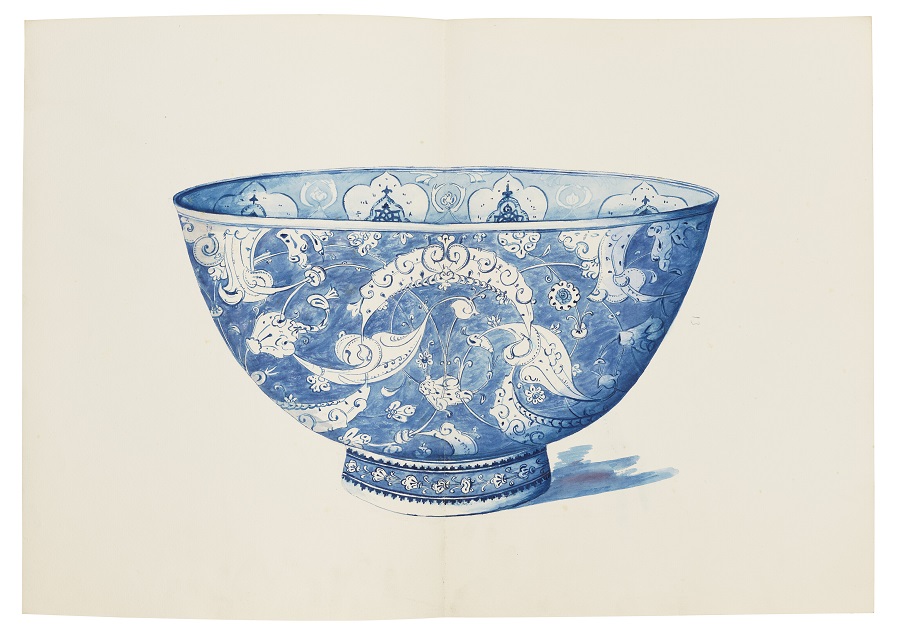
It was also fascinating to see a rare and complete illustrated manuscript copy of the Khamsa of Nizami by 12th century Persian poet Nizami Ganjavi, together with the Khamsa of Amir Khusraw Dihlavi, a 13th century Persian Sufi singer, musician, poet and scholar. The colors in the illuminations leap off the pages as though created yesterday.
Plumbly also pointed out the exceptional workmanship of an early 13th century Kashan pottery bowl, excavated in Iran’s Kashan in 1934.
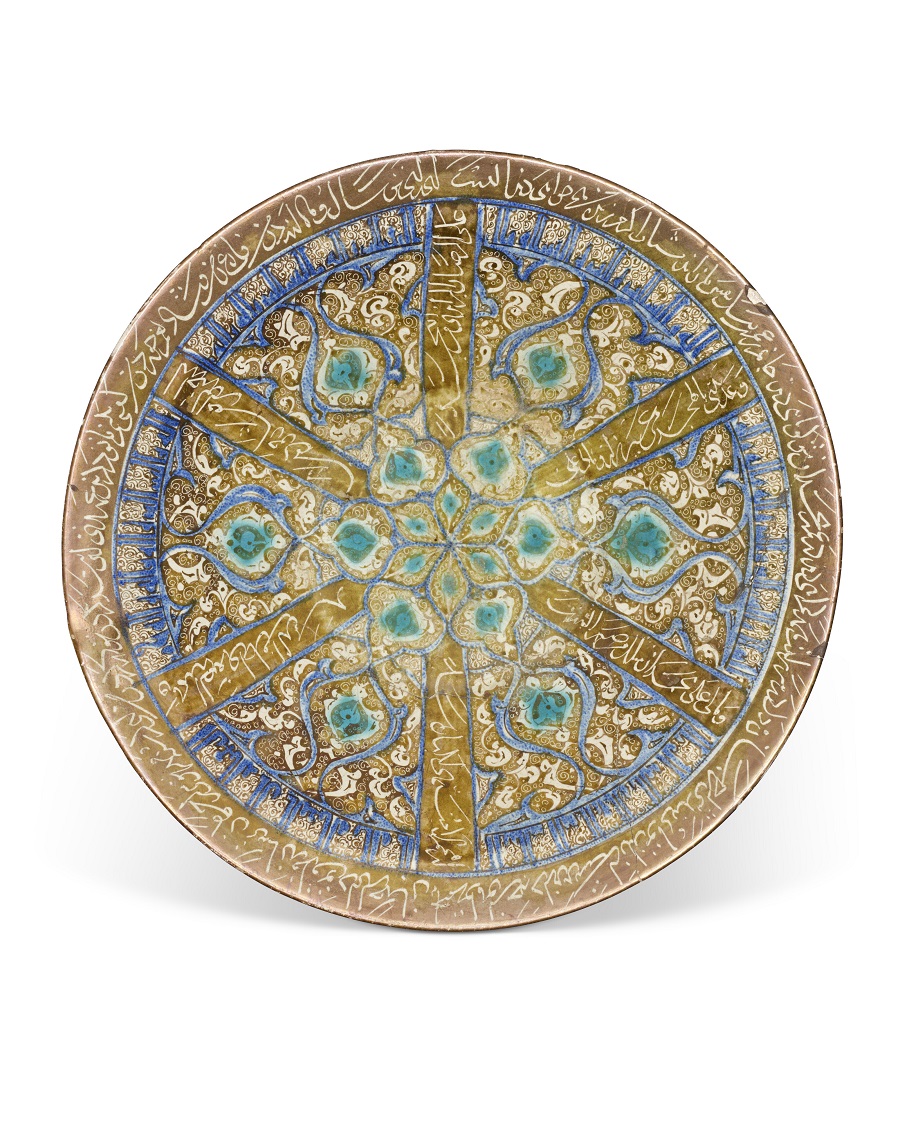
“This type of Kashan ceramics have a wonderful luster. It’s a very difficult technique to perfect. This bowl has a really beautiful dark gold color which is very well controlled. The condition is remarkable. It’s one of those ‘best of type’ objects,” Plumbly observed.
Merwas — Riyadh’s beating heart of creativity
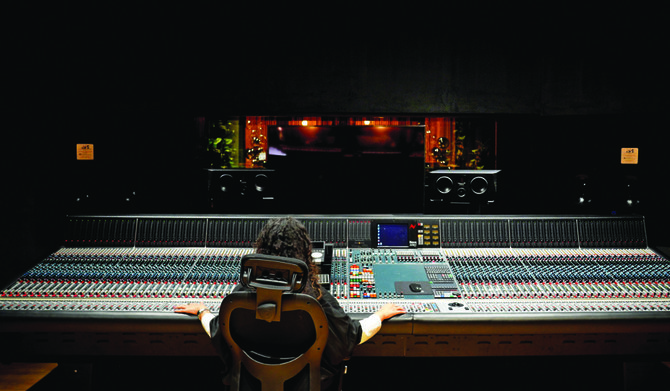
- World’s largest music production studio is nurturing Saudi talent, streamlining local industry
RIYADH: Riyadh’s Merwas, considered the biggest art and entertainment factory globally, is proving to be one of Saudi Arabia’s greatest music industry assets.
Nada Al-Tuwaijri, co-founder and CEO of Merwas, told Arab News that the facility, which holds the Guinness World Record for the largest music production studio, “is home to all artists.”
She added: “The methodology behind it is to create solutions through the subsidiaries, and invest in both talent and infrastructure.
“Alongside it being a one-stop shop for all content creators, we strive to take our local talents from local to global and create a unique stamp in the industry.”
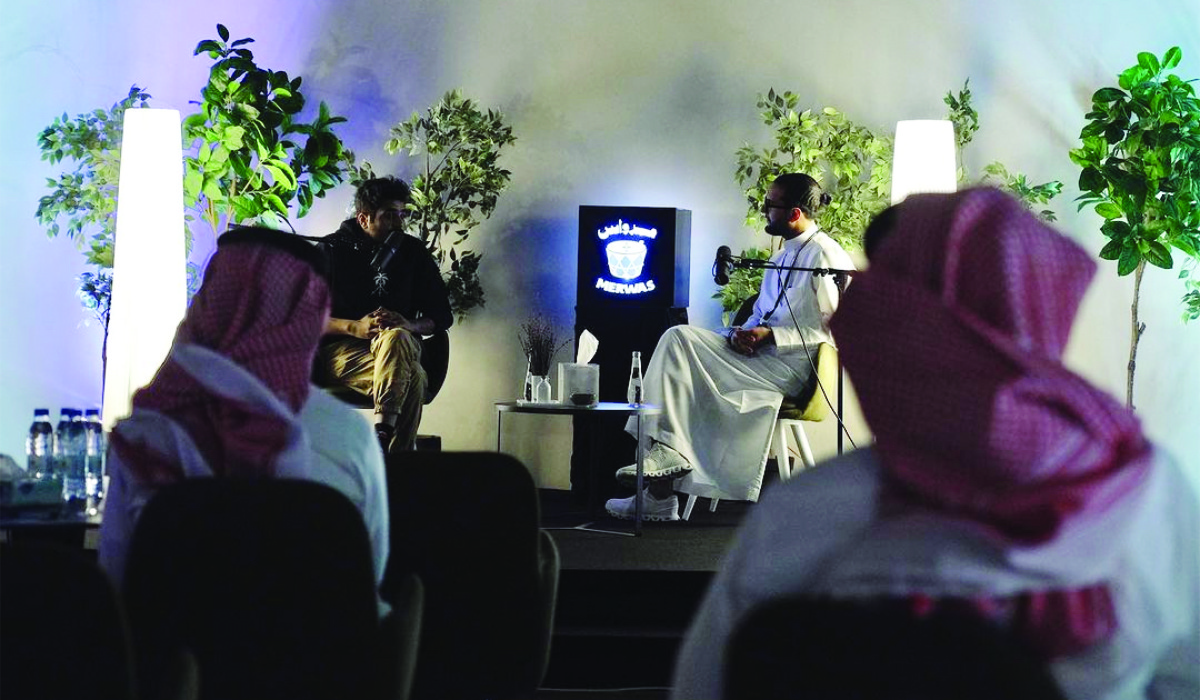
The entertainment zone and audiovisual production studio, located in Boulevard Riyadh City, houses 22 main studios alongside its academy.
Some of the top musicians in the world have visited Merwas since it opened in 2022. These include DJ Khaled, the acclaimed Saudi singer Rabeh Saqer, and the Emirati singer Ahlam. Afrojack, a world-renowned Dutch DJ and producer, also led an electronic music boot camp to nurture local talent and inspire a new generation of Saudi artists.
HIGHLIGHTS
• Merwas, located in Boulevard Riyadh City, houses 22 main studios alongside its academy.
• The academy’s classes offer local creatives and artists direct access to seasoned expertise.
• The Earth Sound Studio, or ESS, named after the late Saudi composer Talal Maddah.
Spread across almost 5,000 square meters, the culture factory fosters creativity, collaboration, and the production of multimedia content, while providing artists with access to top-tier services, facilities and industry expertise.

The Earth Sound Studio, or ESS, named after the late Saudi composer Talal Maddah, features state-of-the-art technology, such as the SSL console, which is used to create depth on music tracks and ensures the true soul of the artist’s voice is protected.
This live recording space is booked almost every day by various artists, and has been used by some of the Arab region’s biggest stars.
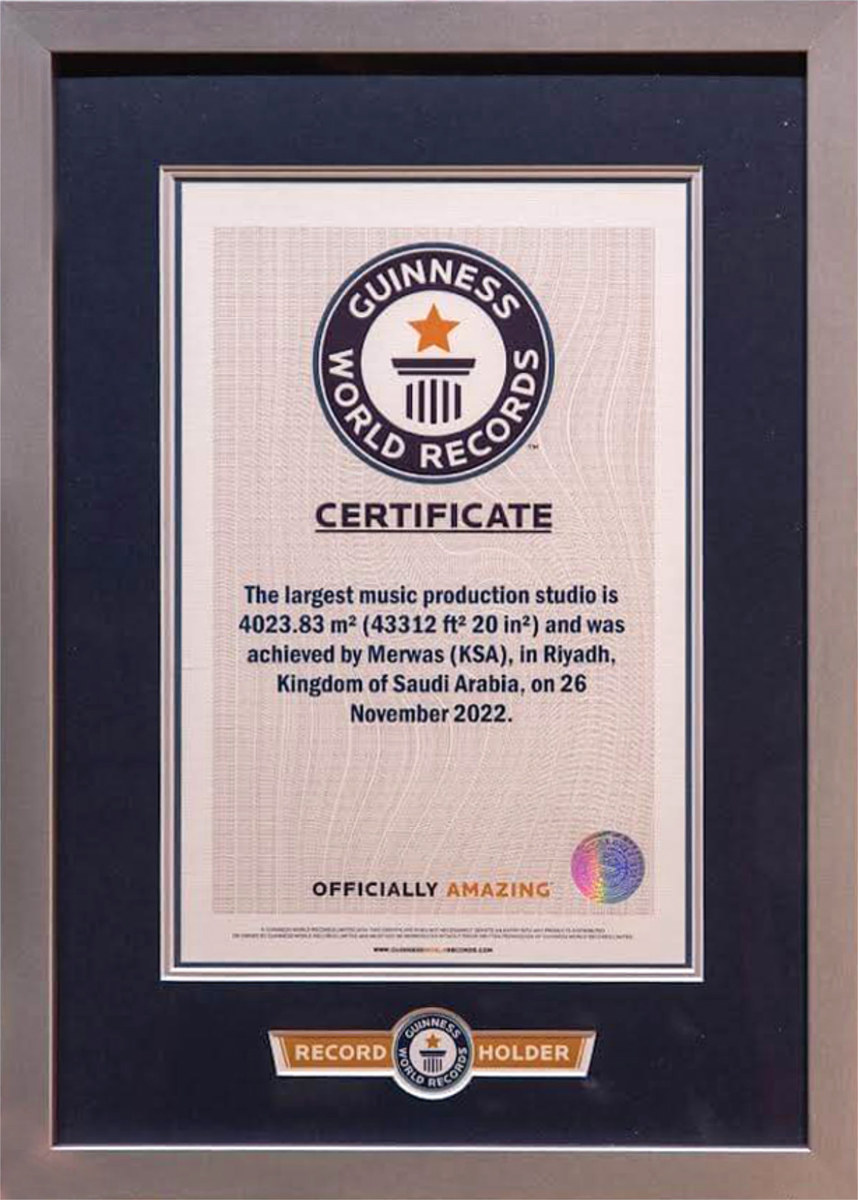
One of the only five Neve consoles in the world can be found in the Neve Studio. The panel is known for its high-quality sound and warmth, and is ideal for music recording, vocal tracking, and mixing for exceptional audio quality.
Its live studio can accommodate over 120 orchestra members and their instruments to provide a unique recording experience.
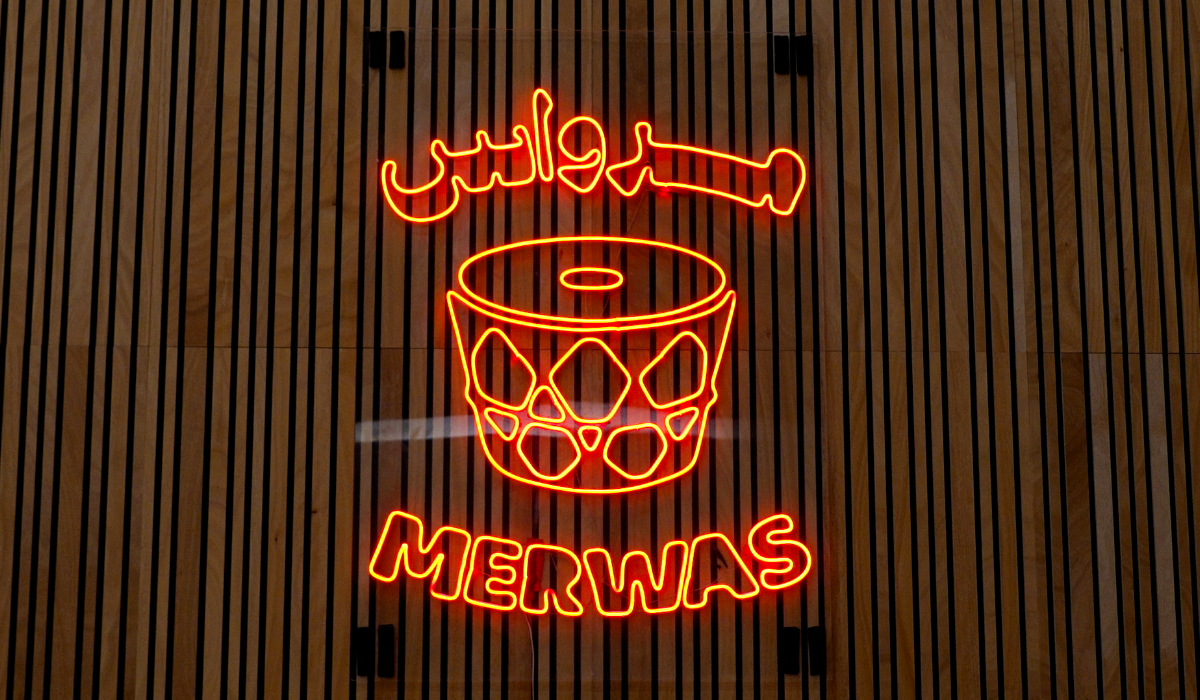
Specifically designed for electronic music production, the EMP Suite is a DJ’s dream, with cutting edge synthesizers and digital audio workstations ensuring an artist leaves the room with a fully produced track.
Merwas is also home to three production suites, designed for content creators who require a comfortable and professional environment for music production, editing, and mixing. Each suite is equipped with industry-standard gear, software, and acoustics to support a wide range of projects.
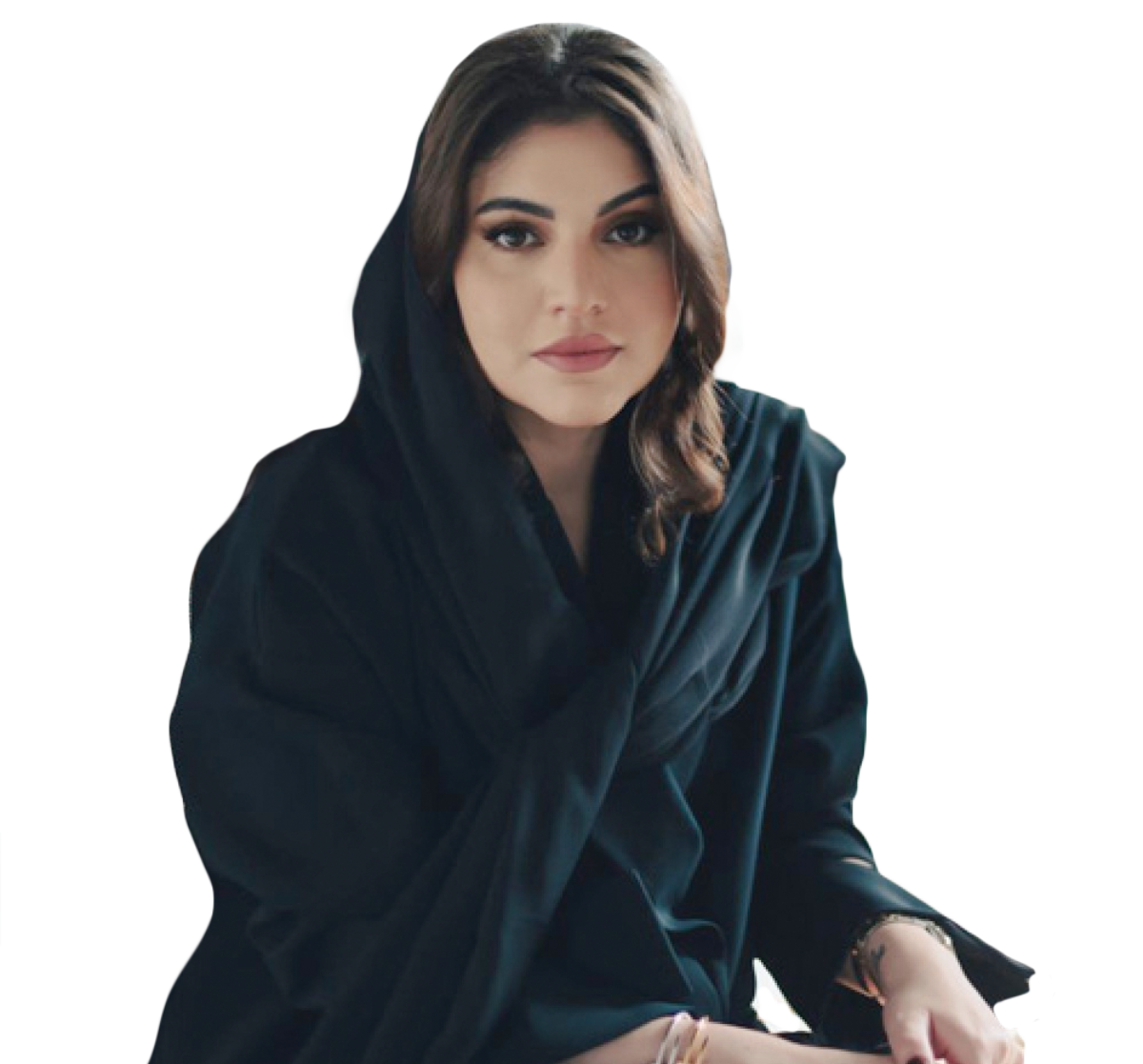
The studio also provides private rehearsal spaces to ensure Saudi talents are nourished to their full potential. The versatile space is designed for musicians, performers, and other artists to rehearse and refine their craft within a comfortable environment with access to instruments and equipment.
Part of the charm of recording studios is the live jam sessions that have given birth to some of the most iconic records to date. Merwas’ Band Live/Control Room also captures the spontaneity of live performance within its soundproof walls.
Alongside (Merwas) being a one-stop shop for all content creators, we strive to take our local talents from local to global and create a unique stamp in the industry.
Nada Al-Tuwaijri, Merwas cofounder and CEO
Championing audiovisual pursuits, the studio has made space for high-quality podcasts and videos to come to life.
The podcast suite and FM radio recording spaces are tailored to immerse listeners with unbeatable audio clarity, while the 25-meter-long Green Screen room helps ideas come to life, whether commercial, film, or music video.

Material can then be edited at the color-grading suite, which is essentially a small theater with 4K projector. Producers, directors, writers, and engineers gather here to put the final visual touches on video projects through its DaVinci color grading software and hardware.
Academy Classes offers local creatives and artists direct access to seasoned expertise. These feature advanced stations for sound production, engineering, and technical programs, with everything necessary for a basic understanding and training of music production.
The studio hosts workshops, networking sessions, and community events in an effort to flourish the music industry locally while making it a magnet for international talent. Anyone can be a part of this community by booking a suite or signing up for a workshop on their website merwas.sa.
Merwas has positioned itself at the the forefront of the entertainment industry being the first of its kind in the MENA region. In less than a year since its launch, it has already became a hotspot for musicians across the globe to visit and utilize its services, from rising talents to international A-listers.
Founded by Al-Tuwaijri and Chief Content Officer Rumian Al-Rumayyan in partnership with Sela, Merwas treasures Saudi creativity and is a vital part of building an ecosystem and community for local artists.
Their partnership with the Saudi Authority for Intellectual Property has set a new focus on preserving the rights of local creatives, pillared by the aim to enrich the culture of the Kingdom while empowering its citizens and their creativity in an environment of abundant knowledge, education in culture, art, entertainment and music.
Hollywood Arab Film Festival: Showcasing Arab cinema in Los Angeles
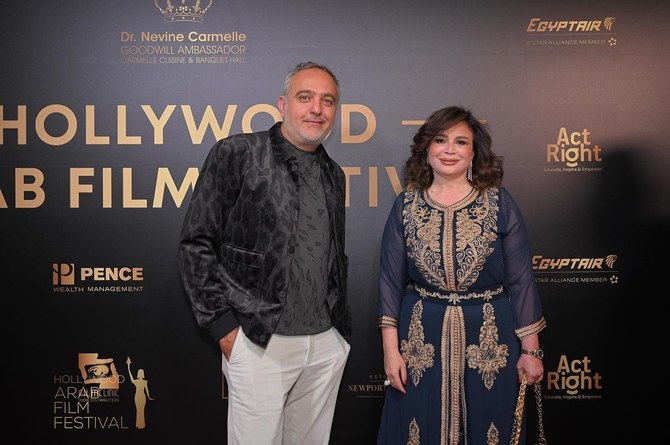
LOS ANGELES: The third annual Hollywood Arab Film Festival began this week, bringing the best of 2024’s Arab cinema to Los Angeles and giving fans a chance to see the films in theaters as well as introducing a new audience to the Arab world’s top talent.
The event, which runs until April 21, was attended by a number of celebrity guests including Egyptian producer and screenwriter Mohamed Hefzy, Tunisian actor Dhaffer L’Abidine, renowned Egyptian star Elham Shahin and Egyptian producer Tarek El-Ganainy.
At the event, Hefty said: “Arab cinema really needs a platform to tell our stories and to show who we are, our identity, our hopes and dreams, our pains, and all the different social topics that are tackled in some of the films that are being presented are maybe more relevant today than ever. So I think it’s a great opportunity to have this dialogue.”
Hefzy’s film “Hajjan” was showing at the event. It is a Saudi Arabia-based film directed by Egyptian filmmaker Abu Bakr Shawky.
“Hajjan is a film about a young boy who got a very special connection to his camel, who has a brother who was a camel jockey and races,” Hefzy said. “And, one day when something really unexpected happens to his brother, and shatters his world, it forces him to step into his brother’s shoes and become a camel jockey, and so starts racing himself.”
The movie is a co-production between the Kingdom’s King Abdulaziz Center for World Culture, or Ithra, and Hefzy’s Film Clinic.
“It was a film made in Saudi Arabia with Saudi talents and actors with an Egyptian director, but with the Saudi co-writer and Saudi actors and shot mostly in Saudi Arabia,” Hefzy said. “So I think it’s, it was a great experience, and learned a lot about Saudi Arabia, learned a lot about the culture.”
The festival featured cinema from various Arab countries, presenting films from 16 different nations. Marlin Soliman, strategic planning director of HAFF, highlighted the inclusion of six feature films, ten short films and six student films.
Spanning five days, HAFF offered its audience a vibrant experience, including a red-carpet affair, panel discussions on filmmaking and diversity in Hollywood, and, of course, screenings of high-profile films.
The festival also saw several filmmakers singing the praises of Saudi Arabia’s expanding film industry.
L’Abidine, the writer and director of “To My Son,” said: “I’m thrilled to be back again with my second feature film ‘To My Son,’ a Saudi film… I think there is a great evolution of Saudi cinema that’s been happening in the last few years.”





